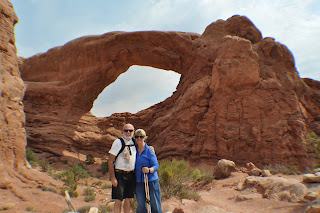 |
| Catching the sunrise at Great Basin National Park, Nevada |
 |
| Crossing Utah the land of great canyons |
Pushing west along Hwy 50, from Moab, Utah we
knocked off 320 miles on the road in six hours to reach Great Basin National
Park in eastern Nevada. It was to be our last big hurrah and proved to be a gem
of a sanctuary, relatively undiscovered. In the shadow of 13,063-foot
Wheeler Peak, where 5,000 year old bristlecone pine trees grow on rocky glacial
moraines, we were fortunate to obtain the last of the limited sites in Upper
Lehman Creek Campground.
People come to GBNP to
experience the solitude of the desert, the smell of sagebrush after a thunderstorm, the darkest
of night skies, and the beauty of Lehman Caves. With the gradual melting of
snow on Wheeler Peak, streams dance down the mountain, diversity explodes, and
bouquets of Prickly-Pear Cacti, Indian Paintbrush , and Globe Mallow begin to
dot the late springtime desert.
 Her
Here we were able to witness
the rare annular solar eclipse happening for the first time in two decades.
Half a dozen high power telescopes for viewing the solar eclipse in the sky
were set up at the visitor center’s parking.
A fellow fully dressed as Galileo
was on the scene to humor and add dimension to the gathering. A chance to see
the stages of the eclipse through the various big telescopes and place our
cameras on several of their lense tubes to take photos was pretty cool.. Unfortunately,
cloud cover dampened the opportunity for seeing the full ring of fire during
the latter stage except for just a few seconds as the moon passed in front of
the sun.

All was not lost, however, as in Great Basin
National Park on a clear, moonless night thousands of stars, five of our solar
system's eight planets, star clusters, meteors, man-made satellites,
the Andromeda Galaxy, and the Milky Way can be seen with the naked eye.
The area boasts some of the darkest night skies left in the United States which
we will attest to having seen.

Touring Lehman Caves within the park through
passages and various chambers to a depth of 194 feet below ground on a ranger 90-minute
tour became great fun. The dim lighting along narrow surface pathways
illuminated the cave for safety. At one point the power went out leaving us all
in total darkness for a period of time. The ranger with his flashlight returned
back and found the auxiliary switch to reboot the lighting in the cave.

Those
hollow rooms and sculptured walls started thousands of years ago as surface
water turned slightly acidic from carbon dioxide gas, mixed with water deep
below the surface, dissolving the soluble rock below were amazing. Drop by drop
trickles of dissolved limestone formed stalactites , stalagmites, columns,
draperies, flowstone, and soda straws within the cavern which continue to grow.
As if a solar eclipse and cave adventure weren’t enough there was still Wheeler Peak Scenic Drive yet to conquer in the park. With
our Jeep we whined up the mountain range through a landscape of forest limber
pines, pinon trees, aspens, and a few bristlecone pine trees before the road ended at the summit’s
10,500 ft elevation parking lot. From there hiking trails lead higher up to
Wheeler Peak at 13,500 ft in elevation. Absolutely
worth giving it a bit of a go I suggested. Now most good hikers usually have
some high altitude training conditioning. So you can imagine it wasn’t long
before we turned and hoofed it back down the trail short on oxygen.

The most we
conquered after that was a few photos from below of the glaciers up on the peak
.
All in all a solar eclipse, cave spelunking, gazing at thousands of bright
stars in a dark night sky, viewing the Great Basin region on a grand scale from Nevada’s
highest peak along with another sunrise as we departed the park made for a grand time before continuing further westward on the
long haul home.














 Touring Lehman Caves within the park through
passages and various chambers to a depth of 194 feet below ground on a ranger 90-minute
tour became great fun. The dim lighting along narrow surface pathways
illuminated the cave for safety. At one point the power went out leaving us all
in total darkness for a period of time. The ranger with his flashlight returned
back and found the auxiliary switch to reboot the lighting in the cave.
Touring Lehman Caves within the park through
passages and various chambers to a depth of 194 feet below ground on a ranger 90-minute
tour became great fun. The dim lighting along narrow surface pathways
illuminated the cave for safety. At one point the power went out leaving us all
in total darkness for a period of time. The ranger with his flashlight returned
back and found the auxiliary switch to reboot the lighting in the cave.


































